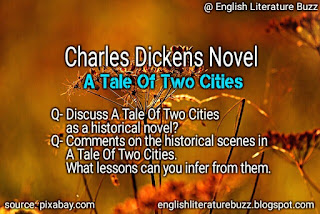Charles Dickens: A Tale Of Two Cities
Q-2 Comments on the historical scenes in A Tale Of Two Cities. What lessons can you infer from them.
A Tale Of Two Cities is a historical novel pertaining to the period before and during the French Revolution. Dickens has already written one historical novel, Barnaby Rudge, which, however, dealt with a period of English history. By the time he wrote A Tale Of Two Cities he was feeling vitally interested in history.
The one thing that everyone who has read A Tale Of Two Cities remembers is the Reign of Terror. And Dickens is very sure that revolution is a monster.
That is why everyone remembers the revolutionary scenes in A Tale Of Two Cities; they have the quality of nightmare, and it is Dickens own nightmare. Again and again he insists upon the meaningless horrors of revolution- the mass butcheries, the injustice, the ever-present Terror of spies, the frightful blood-lust of the mob.
As a historical novel in any literal sense, it has to be kept in mind that Dickens novel does not by any means depict the enormous sweep and drama of the French Revolution in all its complexity.
A number of sources supplied to Dickens for his story of the French Revolution. The main source was Carlyle's French Revolution which Dickens had gone through many times. In this book by Carlyle he found a perfect source for the principal historical scenes and events that he needed for his purpose. The basic idea for the plot was derived by Dickens from a play called The Frozen Deep by Wilkie Collins. Another book which helped Dickens in writing A Tale Of Two Cities was a novel called Zanoni written by Bulwar- Lytton. The early events of Zanoni take place in Italy, but the action soon moves to Paris and to the French Revolution.
Although A Tale Of Two Cities is essentially the story of Dr Manette, Lucie, Darney, and Carton, this story is told against the historical background of the French Revolution. The French Revolution was the gread political upheaval which was caused by the evils of taxation and land- owning system which oppressed the lower classes in France. The disorganized state of national finance under King Louis XVI aggravated the situation in the country. In July 1789, a Paris mob stormed the Bastille, and the disturbances continued thereafter. In 1792, the monarchy was overthrown and France was declared a Republic with "Liberty, Equality, and Fraternity" as its slogan and motto. In 1793, the Reign of Terror started, the King and afterwards the Queen becoming the victims of the guillotine.
The action of A Tale Of Two Cities covers the period from 1775 to 1793 which includes the years of the Revolution (1789-93). It must, however, be kept in mind that the French Revolution is only a secondary theme. Dickens highlights some of the events of the French Revolution such as storming of the Bestille, the senseless fury of the mob, the Reign of Terror etc.
Dickens first reference to the outward causes of the French Revolution in the chapter called "The Wine Shop" in which he uses the symbol of the mill to convey the grinding poverty through which the people of Saint Antoine are passing. Then there are the three chapters in which the callousness and arrogance of a particular nobleman are dipicted. These chapters are " Monseigneur in Town" , "Monseigneur in the Country" , and " The Gorgon's Head. The moseigneur or Marquis Evremonde in these Chapters symbolizes the entire privileged class. The hanging of Gaspard ( the assassin of the Marquis) and the " registration " of the Evremonde family and of the spy John Barsad are pointers in the same direction. One of the best known episodes of the French Revolution is than briefly described by Dickens in the Chapter entitled " Echoing Footsteps". That episode is the storming of Bestille. Madame Defarge's cutting off the head of the governor of the Bestille with her own hands prepares us for the excesses which will be committed by the revolutionaries. The hanging of the old Foulon and his son in law and the setting of the chateau of Evremondes on fire continue the episodic and fragmentary account by Dickens of French Revolution.
These historical scenes in the novel shows that Dickens selected only two actual episodes from the French Revolution- the storming of the Bastille and the lynching of old Foulon and his son in law.
Dickens derived the historical material from this novel from Carlyle's French Revolution which Dickens went through many times. All the historical scenes, to which reference has made above, are based upon Carlyle's book. For instance, Ducken's accounts of the trials, of prison, procedures, of the tumbrils, and of the guillotine all come from Carlyle. Monsieur Defarge and Madam Defarge come indirectly from Carlyle who had mentioned a wine -vender by the name of Cholat as a leader of the lower order if the society, and Carlyle had also mentioned a female leader who was a very impressive mob Captain.
Dickens creates types of the leader of the Revolt from the lowest classes, giving them the names of Jacques One, Jacques Two, Jacques Three, etc.
Dickens's main achievement lies not only in giving us graphic and stirring accounts in the manner of Carlyle, but also interweaving the personal lives of a group of private characters with the events of the French Revolution. These private individuals are Dr. Manette, Lucie Manette, Darnay, and Carton, besides such less important figures as Mr. Lorry, Miss Pross, and John Barsad.

